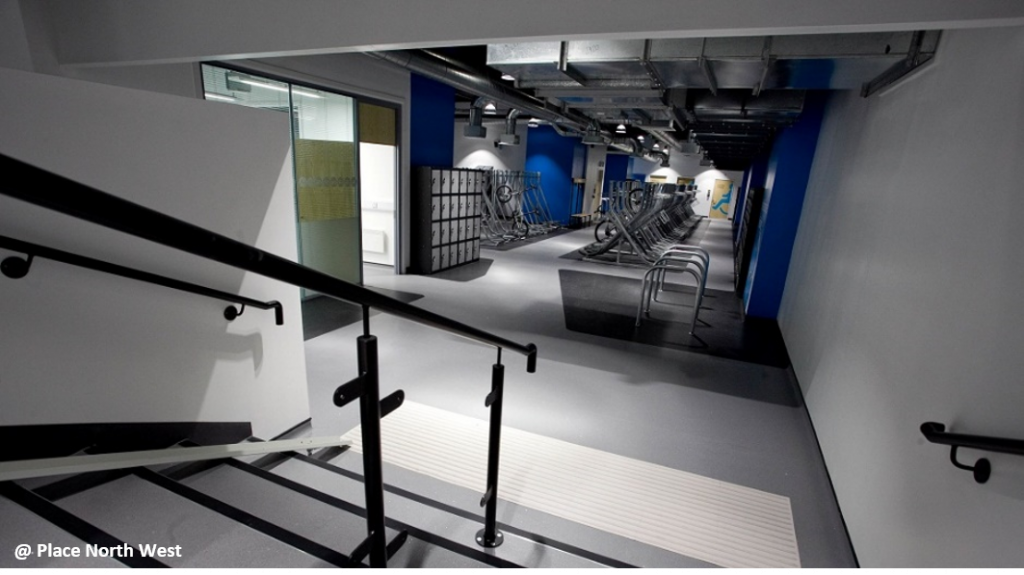
1. Presentation
This measure aims the implementation of spaces and facilities to support cyclists, namely changing rooms and lockers.
2. Objectives
- Making cycling easier by offering conditions that promote cyclists well-being and enhance the experience when they reach the destination.
3. Measure’s Importance
By reducing the barriers associated with cycling, cycling mobility is promoted.
This measure is particularly suitable for initiatives promoted by schools / universities or organizations / companies.
1. Good Practices
– Whenever possible, provide support infrastructures with different bicycle parking options, from simple short-term parking racks to long-term bicycle lockers (See Bike Parking Network).
– Support infrastructures must be safe, illuminated and sheltered from the elements.
– Explain the principles behind the measures to make it clear its importance and impacts (See Information).
– Monitor and reframe measures to meet user needs without compromising sustainable ideals (See Management, Monitoring and Maintenance).
2. Actions
 | Changing rooms Offer changing rooms for cyclists. These can be inserted into existing bathrooms or created separately. These areas should have lockers to ensure the safety of the users, and dryers for clothes and hair to make it easier for cyclists. |
 | Lockers Providing lockers for safely store the necessary cycling accessories. Guarded goods must be secured with the appropriate devices and guarded. |
 | Tools & Maintenance Services Provide bike repair stations with the necessary materials. These can be managed by a professional or not. Also provide air pumps for bicycle tires. |
1. Impacts
 | Mobility system efficiency Promoting bicycle use can lead to the reduction of traffic congestion, contributing also to better efficiency of public transport. |
 | Livable streets By encouraging cycling, urban space welcomes more cyclists, creating more livable and secure streets. |
 | Protection of the environment Encouraging cycling, can reduce car use and pollutant emissions. |
 | Inclusion, equity and accessibility Raising the status and end the stigma around cycling increases the range of transport possibilities for everyone, including to the disadvantaged families. However, the needs of people with motor disabilities must also be addressed. |
 | Safety and comfort Eliminate the hassle of perspiration and provides a safe place to store cycling accessories. |
 | Economic value Some facilities charge a symbolic fee for their use, allowing the initial investment to be recovered. |
 | Awareness and acceptability By eliminating uncomfortable situations, barriers to cycling are reduced. |
Legend:
| Very positive | Positive | Neutral | Negative | Very negative |
2. Barriers
 | Legal No barriers. |
 | Finance Implementation of this measure entails some costs. |
 | Governance This measure can be implemented by companies, organizations, schools or from a government project. Depending on the case, coordination between government authorities and private or semi-private groups may be required. |
 | Political acceptability No barriers. |
 | Public acceptability No barriers. |
 | Technical feasibility Designing new spaces with plumbing infrastructure requires specific expertise. |
Legend:
| No barrier | Minimum barrier | Moderate barrier | Significant barrier |
3. Budget
| Area | Measure | Unit | Cost | Implementation year |
| Matosinhos, Porto Metropolitan Area (Portugal) | Acquisition of support facilities | 5 electronic lockers and 1 freestanding kiosk | 49 590,00 € | 2018 |
| Manchester Metropolitan Area (U.K.) | Bicycle station construction with showers, toilets, lockers and a bicycle repair centre | 2 stations | £ 0.40 – £ 0.70 million | Information gathered from a 2017 study |
| Manchester Metropolitan Area (U.K.) | Business grants to fund CCTV security, lockers, drying rooms and bicycle hangers | 84 companies and 1228 bike parking spaces | £ 0.75 million (average £ 6,000 /grant, limited to £ 10,000 * | Information gathered from a 2017 study |
| Birmingham Metropolitan Area (U.K.) | Business grants to fund bicycle shelters, bicycle hangers, showers, hairdryers, lockers, drying rooms, CCTV security, repair stands, bicycles and safety equipment for business trips, toolkits and pump stations | 27 workplaces | £ 0.20 million (average of £ 7,000 /grant, limited to £ 10,000) * | Information gathered from a 2017 study |
| Austria | Lockers | 1 locker | 300,00 € | Information gathered from a 2013 study |
* Employees were required to provide part of the funding. In Birmingham’s case money could be replaced by work hours.
Case study 1: Manchester Metropolitan Area (U.K.)

In Manchester, Transports for Greater Manchester (TfGM), the government entity responsible for transports, created the Cycle Hubs – bicycle stations to promote cycling as an efficient means of commuting to work. Some stations have showers, toilets, lockers and a bicycle repair centre. One of these stations is located under the City Tower in Piccadilly. There is a charge of £ 100 / year for parking and £ 200 / year to access all facilities.
Impact:
 | Mobility system efficiency Promoting cycling over car travel to reduce traffic and congestion. This leads to better efficiency of public transport. |
 | Livable streets In addition to information about Cycle Hubs, TfGM also facilitates contact between cyclists and promotes cycling events, that create more dynamics and activities on the streets. |
 | Protection of the environment The provision of support infrastructures as an incentive for cycling is an integral part of TfGM's Clean Air plan. The plan aims to reduce car pollutant emissions through a set of measures, including the promotion of cycling. |
 | Inclusion, equity and accessibility Raising the status and end the stigma around cycling increases the range of transport possibilities for everyone, including to the disadvantaged families. However, the needs of people with motor disabilities must also be addressed. |
 | Safety and comfort Eliminates the hassle of perspiration and provides a safe place to store cycling accessories. |
 | Economic value Some facilities charge a symbolic fee for their use, allowing the initial investment to be recovered. |
 | Awareness and acceptability By eliminating uncomfortable situations, barriers to cycling are reduced. |
Legend:
| Very positive | Positive | Neutral | Negative | Very negative |
Taylor, I. & Hiblin, B. (2017). Typical Costs of Cycling Interventions: Interim analysis of Cycle City Ambition schemes. Accessed 2 July 2019. Available at: http://www.transportforqualityoflife.com/policyresearch/cyclingandwalking/
IMPIC. Base: Contratos públicos online. Accessed 19 June 2019. Available at: http://www.base.gov.pt/Base/pt
Place North West (2012) City Tower cycle park opens. Consulted 19 June 2019. Available at: https://www.placenorthwest.co.uk/news/city-tower-cycle-park-opens/
Transport for Great Manchester (2019) Cycling. Accessed 19 June 2019. Available at: https://tfgm.com/cycling
